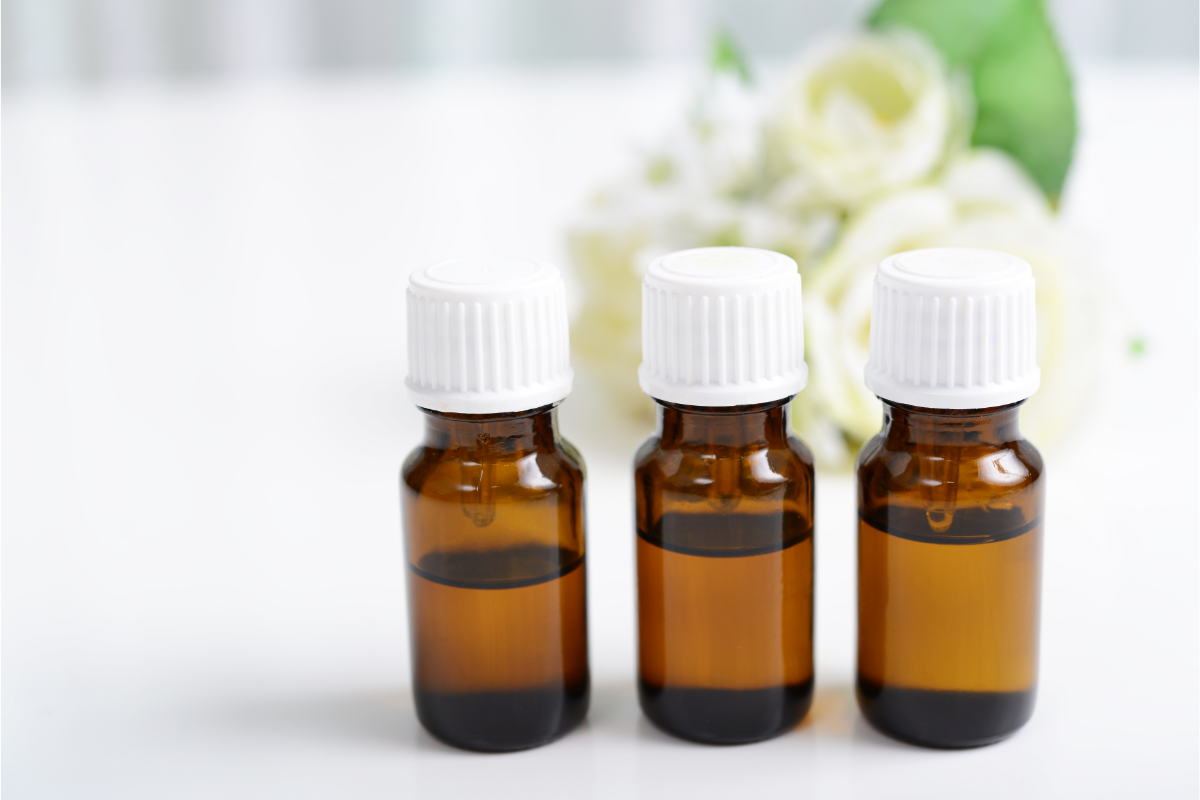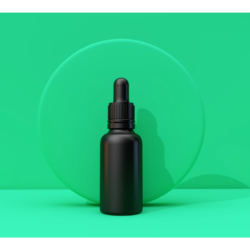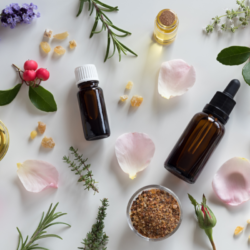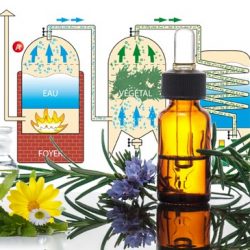The European Pharmacopoeia defines essential oils as “odorous products, generally of complex composition, obtained from a botanically defined plant raw material, either by steam distillation, dry distillation, or by an appropriate mechanical process without heating”.
The use of essential oils in pharmacies means that medical advice can be personalised and an interdisciplinary approach approach to treatment. Their administration by the skin is often preferable for its simplicity and effectiveness, minimising systemic side effects. Depending on the therapeutic objectives, essential oils can be used in either preventive or curative regimens by adjusting the dosage and frequency of administration.
What is an essential oil?
The essence is produced within the plant and is characterised by its low presence, generally between 1 and 3% of the total plant. This essence, the product of plant life, fulfils a number of crucial functions within the plant.
Firstly, it helps to preserve the plant’s immunity, acting as a first line of defence against external aggression.
In addition, this essence plays an essential role as an energy reserve, providing the plant with the energy it needs to support its vital processes, particularly during periods of stress or increased need.
Finally, the essence also has the function of protecting the plant, acting as an active component that can deter predators or pathogens, thus contributing to the plant’s survival and health.
How is an essential oil obtained?
Essential oils are mainly extracted by steam distillation from aromatic plants such as lavender, tea tree or peppermint. In this method, the aromatic plants are suspended over a container of boiling water. The steam releases the plants’ volatile compounds, which are then captured to obtain a concentrated liquid extract.
The transition from essence to essential oil is at the heart of aromatherapy, a discipline that was born in 1928 thanks to René-Maurice Gattefossé.
The word “aromatherapy” can be broken down into two Greek roots: “aroma”, meaning fragrance, and “therapy”, referring to a curative or palliative approach. The term therefore encompasses methods designed to treat and relieve pathological conditions or ailments using aromatic substances.
Aromatherapy relies on two main manufacturing processes to extract essential oils:
- Mechanical expression: This process involves mechanically pressing plant parts, such as citrus peel, to release the essential oils they contain. The product is called “essence”.
- Distillation: This is the process of heating followed by condensation of the water vapour loaded with essential oils extracted from the plants. This is the most commonly used method for obtaining essential oils from aromatic plants. The product is called an “essential oil”.
These two production processes contribute to the overall concept of “essential oils”. They are then used in aromatherapy to exploit their therapeutic virtues and their potential for improving health and well-being.
What is aromatherapy?
Aromatherapy is a discipline that encompasses the therapeutic use of essential oils. It focuses on the study of the olfactory properties of plants and the influence of these aromas on the physical and psychological well-being of the individual, as well as on the environment. Aromatherapy is a multi-disciplinary field that incorporates a variety of treatment methods and techniques. It encompasses the atmospheric diffusion of oils, topical applications through massage, and even their oral ingestion for therapeutic purposes.
Essential oils have a multitude of applications and can offer many benefits for our bodies. Some essential oils even have the ability to influence our emotions and overall well-being.
Generally, each essential oil has specific properties, such as relieving congestion, reducing inflammation, treating nausea or joint pain, among others.
It is therefore imperative to learn about the use of these essential oils. Specialised training in aromatherapy is highly recommended to handle these substances safely and carefully.
What are their applications?
Each essential oil is made up of a broad spectrum of active aromatic molecules, specially recognised for their therapeutic effects and beneficial contributions to human health. These essential oils are found in various anatomical parts of the plant, including the bark, pods, roots and flowers.
Depending on their specific application and associated claims, essential oils fall under various regulations, including those concerning cosmetic products, biocides such as sanitising sprays, or plant-based medicines. An essential oil acquires the classification of medicinal product when it is promoted for its therapeutic properties to treat or prevent human medical conditions, or when it demonstrates a confirmed pharmacological, immunological or metabolic activity.
Essential oils can also be used as excipients in the composition of a medicinal product, for example as flavouring agents. In the pharmaceutical sector, these oils are available either as magistral preparations or in their original, unmodified form.
Notion of chemotype
The concept of chemotype, in aromatherapy, refers to a very specific chemical reality: a distinct chemical entity within the same species. Although essential oils share the same Latin name for a given species, their biochemical composition can vary considerably depending on their geographical origin.
Two predominant methods are used to identify chemotypes:
- In Latin: The name of the genus and species of the plant is associated with “CT” (for Chemotype), followed by the molecule that defines this specific chemical variant of the essential oil.
- In French: For ease of understanding, the name of the genus and species is supplemented directly by the molecule that characterises this particular chemotype.
These details are essential for accurately identifying essential oils and understanding the subtle variations in their chemical composition depending on their geographical origin, which can have a significant impact on their therapeutic properties and their use in aromatherapy.
Pharmacodynamic properties
Essential oils have distinctive physical properties that set them apart:
- They are in liquid form at room temperature, which makes them easy to handle.
- Although they have an oily texture, they are not greasy to the touch (volatile).
- Their density is generally lower than that of water, which means they float on water.
- They are insoluble in water and do not mix with it.
- However, they are soluble in alcohol, fats and certain solvents. This solubility varies according to the specific chemical composition of each essential oil.
Essential oils are distinguished by their specific physico-chemical properties, which are essential for understanding their therapeutic use.
- Composed of hundreds of different constituents, each contributes to their complex chemical composition.
- Even minor constituents are important in their therapeutic action. Often, even in small quantities, these constituents can have a significant impact on the properties of the essential oil.
- The aromatogram enables the correlation between the biochemical structure of essential oils and their therapeutic efficacy to be analysed, highlighting the interaction between the various compounds to generate specific effects.
The general properties of essential oils include:
- Anti-infective properties, acting against bacteria, viruses and fungi (fungicides).
- Other properties such as anti-inflammatory, antispasmodic, analgesic (against pain), digestive, healing, endocrine-regulating and immunoregulating, making them versatile substances for health and well-being.
- Essential oils also act on olfactory receptors and nerve centres, which can influence people’s behaviour and emotional state.
These varied physico-chemical and therapeutic properties make essential oils natural compounds of great importance in various fields, from natural medicine to perfumery and aromatherapy.
Essential oils reserved for pharmacies
Certain essential oils (EO) are reserved for dispensing in pharmacies. They are subject to specific regulations, particularly because of their chemical composition and potentially dangerous properties. The legislation governing their use includes several decrees and laws. Law no. 84-534 of 30 June 1984, supplemented by the decree of 23 June 1986, regulates the dispensing of 8 specific essential oils. A decree dated 3 August 2007 extended this list to 15 essential oils. These are mainly essential oils rich in thujone and pinocamphone.
The essential oils covered by these regulations include :
- Wormwood(Artemisia absinthium L.)
- Petite wormwood(Artemisia pontica L.)
- Common wormwood(Artemisia vulgaris L.)
- White wormwood(Artemisia herba alba Asso)
- Artemisiaarborescens (Artemisia arborescens L.)
- Eastern white cedar(Thuya occidentalis L.) and Korean cedar(Thuya Koraenensis Nakai), also known as “leaf cedar”
- Hyssop(Hyssopus officinalis L.)
- Sage (Salvia officinalis L.)
- Tansy(Tanacetum vulgare L.)
- Cedar(Thuya plicata Donn ex D. Don.)
- Sassafras(Sassafras albidum [Nutt.] Nees)
- Sabine(Juniperus sabina L.)
- Rue(Ruta graveolens L.)
- Chenopodium vermifuge(Chenopodium ambrosioides L. and Chenopodium anthelminticum L.)
- Yellow mustard(Brassica juncea [L.])
In addition, essential oils containing anethole, found in anise(Pimpinella anisum), fennel(Foeniculum vulgare), star anise(Illicium verum), hyssop and wormwood, can only be supplied on medical prescription. These essential oils are subject to restrictions due to their neurotoxic potential.
It should be noted that dill, although it does not contain anethole, is also considered to be neurotoxic.
The aim of these regulations is to ensure the safety and protection of public health by limiting access to potentially dangerous essential oils and reserving them for controlled and informed use in medical or pharmaceutical environments.
What method of administration and dosage should I choose?
We assume that 1 ml is equal to 30 to 35 drops on average, depending on the laboratory. One drop is therefore worth approximately 30 to 35 mg.
Cutaneous use
The cutaneous route is a method of administering essential oils that deserves particular attention. This preference is explained by the lipophilicity of essential oils, which makes them perfectly compatible with the skin.
In everyday practice, the commonly recommended doses are 3 to 5 drops of essential oil for every 10 ml of vegetable oil. This represents approximately 1 to 3% of essential oils in the mixture. It should be borne in mind, however, that there is a risk of skin irritation with certain essential oils rich in compounds such as thymol, carvacrol and eugenol (phenols), as well as cinnamaldehyde, pinenes and citrals. Sportsmen and women use the benefits of essential oils in a compress for sprains or bruises.
To minimise these risks, it is advisable to dilute essential oils in vegetable oils. Dilution percentages vary according to the purpose of the application:
- 1%: For use in dermocosmetics.
- 3%: For repairing the integuments, for example in the nose, ears or vagina.
- 5%: To act on the central nervous system, in particular to relieve stress and promote well-being.
- 7 % : Used for circulatory actions, both blood and lymphatic.
- 10%: Used for muscular, tendon or joint actions.
- 15 %: For uses related to sport and competition.
- 20%: Used for powerful systemic or local actions, for example in the cellulolytic field.
- 50%: Pure use, although therapists are generally reluctant to use such a high concentration.
- 99%: In exceptional cases, pure essential oils such as fine lavender or ravintsara may be used.
Airborne use
Atmospheric diffusion of essential oils is a preventive practice that complements treatment. Here are a few recommendations for safe and effective diffusion:
- Olfactory ambience: When using atmospheric diffusion, it is advisable to programme sequences with a diffuser for about 10 minutes an hour.
- Dry inhalation: Dry inhalation involves placing a few pure drops of essential oil on a handkerchief. However, this practice should be avoided by children under the age of 3, people suffering from epilepsy and asthmatics.
- Wet inhalation: For wet inhalation, mix 3 to 8 drops of essential oils in an inhaler bowl. This method is recommended for adults and children over the age of 12. The session lasts 3 to 7 minutes and can be repeated 2 to 3 times a day.
It is essential never to diffuse essential oils in a sleeping child’s bedroom. If pets are present, they must be able to leave the room during the diffusion. Irritating essential oils such as thymol, carvacrol, eugenol, etc. should be avoided when diffusing. These precautions are crucial to safe and beneficial atmospheric diffusion. The appropriate use of essential oils in the air can help to create a pleasant atmosphere and promote well-being, but it must be done with caution, especially in the presence of young children or people with specific medical conditions.
Aromatic baths and showers
Aromatic baths combine hydrotherapy and aromatherapy to offer a range of therapeutic benefits, from muscle relaxation to improved circulation and breathing. Depending on the temperature of the water, there are three main types of aromatic bath: hot, warm-warm and cold.
- Hot baths, with a temperature of between 37 and 42°C, are effective in stimulating blood circulation and promoting the elimination of toxins. However, they are not recommended immediately after physical exertion or during digestion, and should not last longer than 10 minutes.
- Warm-warm baths, at temperatures of 30 to 36°C, are universally suitable for treating a wide variety of ailments without significant side effects. They are particularly useful for encouraging relaxation and sleep.
- Cold baths, at temperatures between 10 and 25°C, do not offer the benefits of absorbing essential oils and focus instead on the effects of the temperature of the water itself.
To incorporate essential oils into these baths, careful dilution is required. Up to ten drops of essential oil can be added to 100 litres of water, in combination with a dispersant, such as solubol or labrafil, in a quantity four times greater than that of the oil to ensure a proper emulsion.
Galeras White burner
Using a burner, you need to put water in the dish and add a few drops of essential oil, then light a tea light underneath. The candle will heat the dish and the water and oil will evaporate into the air. A burner is ideal for diffusing in a room. The essential oil will penetrate the body by inhalation and also by contact with the skin.
You can use an electric diffuser. Much more powerful in terms of evaporation, you can diffuse it throughout the house at the same time. Efficient, but less warm than a traditional burner. Be careful not to saturate the air with aromatic molecules.
By mouth
There are important recommendations for safe and effective oral administration of essential oils.
The dosage for oral administration of essential oils is as follows:
- For adults, the recommended dosage is a maximum of 6 drops of essential oil per day, divided into 2 drops, three times a day.
- For children, the quantity is limited to a maximum of 3 drops per day, divided into 1 drop, three times a day.
- Essential oils should never be taken orally by children under the age of 7.
Diluting essential oils is an essential step when using them orally. Essential oils should be diluted in a suitable medium, such as vegetable oil, honey, compote or a neutral lactose-free tablet. This dilution is necessary to reduce the concentration of essential oils and thus minimise potential risks. It is advisable to take essential oils with meals. The aim of this practice is to reduce the risks by ensuring that the essential oils are ingested at the same time as food. This may help to reduce their potential impact on the stomach and digestive tract.
Rectal use
The rectal route is the human body’s most efficient absorption method (recommended for combating dehydration in extreme situations) thanks to the high permeability of the veins in the rectum. These aromatherapy remedies can be absorbed using a suppository. This procedure is used for people who cannot absorb oil orally (fragile mucous membranes and digestive tract…). Ask a specialist for advice before use. Rectal administration of essential oils requires a medical prescription.
Essential oils can be administered rectally in the form of suppositories. The average dose of essential oil used varies from 75 to 100 mg. For chronic treatment, the recommended dosage is 10 mg per kilogram of body weight per day, with a maximum dose of 40 mg of eucalyptus essential oil (E) and 80 mg of softener essential oil (AD), not exceeding a total of 150 mg per day. The usual dosage is one suppository twice a day.
The rectal route allows good resorption of essential oils, making it a suitable option for children and adults with gastric intolerances. However, this method is contraindicated in cases of haemorrhoids or haemorrhagic rectocolitis. In gynaecology, a concentration of 5 to 10% of essential oils is generally used in ovules.
Precautions when using essential oils
It is essential to take several precautions into account when using essential oils.
General precautions
- Never inject essential oils.
- We strongly advise against using essential oils on pregnant women, while breast-feeding and on children under the age of 3.
- It is essential not to leave bottles of essential oils within the reach of children. Store them carefully, preferably upright.
- Avoid using pure essential oils, with exceptions such as true lavender, ravintsara, rosewood, etc.
- Never apply pure essential oils to the eyes or mucous membranes.
- Avoid using essential oils directly in bath water.
- Do not expose essential oils to the sun, as some of them have different properties and therefore specific effects, and may be phototoxic.
- In the event of an allergic reaction, carry out a skin test in the crease of the elbow and wait about 15 minutes to observe any reaction.
- Before use, be sure to check the appropriate method of administration and dosage for each variety of essential oil.
Storage
- Do not leave essential oil bottles within the reach of children. Store them carefully, preferably upright.
- Store away from light, preferably in a coloured or aluminium bottle in a cupboard.
- Keep the storage temperature between 5 and 35 degrees Celsius maximum.
- Respect the shelf life, which is generally 5 years for essential oils and 3 years for essences.
These precautions apply to all essential oils. However, some have specific contraindications, so check with a health professional.
What to do in the event of an accident
- In the event of accidental ingestion of an excessive quantity of essential oil, it is essential to contact the Poison Control Centre immediately. If you accidentally ingest too much essential oil, you should take around 30 ml of vegetable oil to dilute the substance and minimise the associated risks.
- If an essential oil comes into contact with the eyes or causes a skin burn, a vegetable oil, such as sweet almond oil, should be applied immediately to dilute and reduce the irritating effect.
Oral administration offers the advantage of rapid action of essential oils. Although the oral route offers rapid action, this method has its limitations. It is strictly forbidden for pregnant women, people suffering from epilepsy and children under the age of seven. It is also not recommended for people with a history of ulcers, gastric disorders or gastro-oesophageal reflux. The strong taste of essential oils is also a disadvantage. Peppermint should be avoided by people with asthma.
Toxicity of essential oils
An active substance is a chemical component with specific biological effects that may also be potentially toxic. This toxicity is not uniform and may vary according to several factors, including the biochemical composition of the substance, the dose administered, the route of administration and the physiological state of the exposed individual.
Dermocaustic essential oils
Dermocaustic toxicity is one of the potential side effects associated with the use of certain essential oils (EO). This phenomenon manifests itself as skin irritation or burning and often requires adequate dilution to minimise these risks. Different biochemical compounds in EOs are responsible for this irritant effect.
Essential Oils with Phenols
- Notable compounds: Thymol, Carvacrol, Eugenol
- Examples of EOs: Thyme ct thymol, Savory, Oregano compact, Clove tree
- Effect: These compounds are very irritating to the skin and can cause burns if used without appropriate dilution.
Aromatic aldehydes
- Notable compounds: Cinamaldehyde
- EO examples: Cinnamon (leaves and bark)
- Effect: This compound can be highly irritating to the skin and mucous membranes, requiring careful dilution.
Terpene Aldehydes
- Notable compounds: Citrals and Citronnellal
- Examples of EOs: Verbena, Lemon Eucalyptus, Lemongrass, Lemon Litsée, Lemon Balm
- Effect: These essential oils are moderately irritating to the skin and irritating to mucous membranes.
Pinenes
- Notable compounds: Pinenes
- Examples of EOs: Pine, Fir
- Effect: Although generally less irritating than the previous categories, these essential oils can still cause some skin irritation.
Photosensitising essential oils
Exposure to ultraviolet rays, whether from the sun or artificial sources, can cause undesirable effects when certain essential oils are applied to the skin or ingested orally. The compounds responsible for this effect are mainly furocoumarins.
Essential oils containing Furocoumarins
- Citrus peel (genus Citrus): Lemon, Orange, Grapefruit, Mandarin
- Bergamot: Particularly rich in Bergaptene
- Apiaceae: Angelica, Khella, Cumin
Associated risks and precautions
- Direct sunlight or UV exposure: It is imperative to avoid direct sunlight or UV exposure for at least 6 hours after applying an EO containing furocoumarins to the skin or taking an EO by VO.
- Avoiding the Sun and UV Sources: Avoid all direct exposure to the sun and all sources of UV radiation during the risk period.
Allergenic essential oils
The allergenicity of essential oils (EO) can vary considerably depending on the patient’s individual skin type. Certain compounds, such as sesquiterpene lactones, are particularly notorious for their allergenic potential. Before any cutaneous application, a skin test should be carried out to assess individual sensitivity to the components of the essential oil.
Sesquiterpene Lactone Essential Oils
- Examples of EO: Laurel, Mugwort, Sweet Flag
- Precautions: A skin test is recommended before any topical application of essential oils.
Specific risks associated with Peppermint EO
- Risk populations : Not recommended for children under 12 years of age due to the risk of bronchospasm. Not recommended for people with asthma or epilepsy.
- Limitations on use : Limited cutaneous use. Avoid air diffusion.
Hepatotoxic essential oils
Liver toxicity is a serious issue to be considered when certain essential oils (EO) are administered orally. Many biochemical compounds present in essential oils are notorious for their potential hepatotoxicity, phenols in particular.
Essential Oils with Phenols
- Notable compounds: Thymol, Carvacrol, Eugenol
- Route of administration: Oral
- Dosage for adults: 1 drop 3 times a day orally (VO)
Precautions on Dosage and Duration of Treatment
- Quantitative Limitation: Dosage should not exceed 500 mg per day.
- Temporal limitation: Treatment should not exceed 3 weeks.
Complementary recommendations
Some experts recommend combining a hepatoprotective essential oil such as Carrot, Thujanol Thyme, Lemon or Rosemary Verbenone to minimise the risk of hepatotoxicity.
Neurotoxic and abortifacient essential oils
The use of certain essential oils (EO) can present risks of neurological toxicity and abortifacient effects, particularly when they contain specific ketones. These compounds, often identified by their ‘one’ suffix, require special attention because of their toxic potential.
Essential oils containing ketones
- Notable compounds: Thujone, Pulegone, Italidione, Menthone, Piperitone, Verbenone
- Examples of EOs: Helichrysum, Peppermint, Sage, Rosemary Camphor, Atlas Cedar
Restrictions on use
- Pregnant and breast-feeding women: Contraindicated due to risk of abortifacient effects.
- Infants and Children under 6: Contraindicated due to increased risk of neurological toxicity.
- History of Epilepsy: Avoid due to potential to cause seizures.
- Elderly: Use is not recommended due to increased susceptibility to neurological toxicity.
- Oral route: This method of administration presents a particularly high risk of neurotoxic effects and is therefore contraindicated for specified risk groups.
Nephrotoxic essential oils
Prolonged oral administration of certain essential oils containing monoterpenes increases the risk of renal toxicity. In addition, some monoterpenes also have dermocaustic properties.
Monoterpene Essential Oils
- Examples of EOs: Pine, Fir, Juniper, Sandalwood, Cypress
- Route of administration: Particularly risky if used orally for prolonged periods.
- Pinene Essential Oils: Scots Pine, Lemon, Balsam Fir, Black Spruce, Juniper
Limitations and precautions
- Duration of treatment: Avoid the oral administration of e.o over a prolonged period due to the increased risk of renal toxicity.
- Dermal caution: Use caution when applying essential oils containing pinenes to the skin, as they may be irritating to the skin. For dermal applications, we therefore recommend diluting these oils appropriately or avoiding them altogether.
Sources
- https://ansm.sante.fr/qui-sommes-nous/notre-perimetre/les-medicaments/p/medicaments-a-base-de-plantes-et-huiles-essentielles#:~:text=A%20essential%20oil%20is%20the%C3%A9definition%20of%20the%20Pharmacop%C3%A9e%20europ%C3%A9enne).
- https://dumas.ccsd.cnrs.fr/dumas-01719690/document
- https://www.anses.fr/fr/system/files/NUT2018SA0096.pdf
- https://pranarom.fr/pages/distillation-des-huiles-essentielles
- https://www.tisserandinstitute.org/essential-oils-in-hospitals/
- https://www.ncbi.nlm.nih.gov/pmc/articles/PMC5206475/
- http://www.nccih.nih.gov/
- Licence Professionnelle CSHPSP course year 2021-2022 “Les Fondamentaux en Aromathérapie” taught by Sandrine Peyrat





